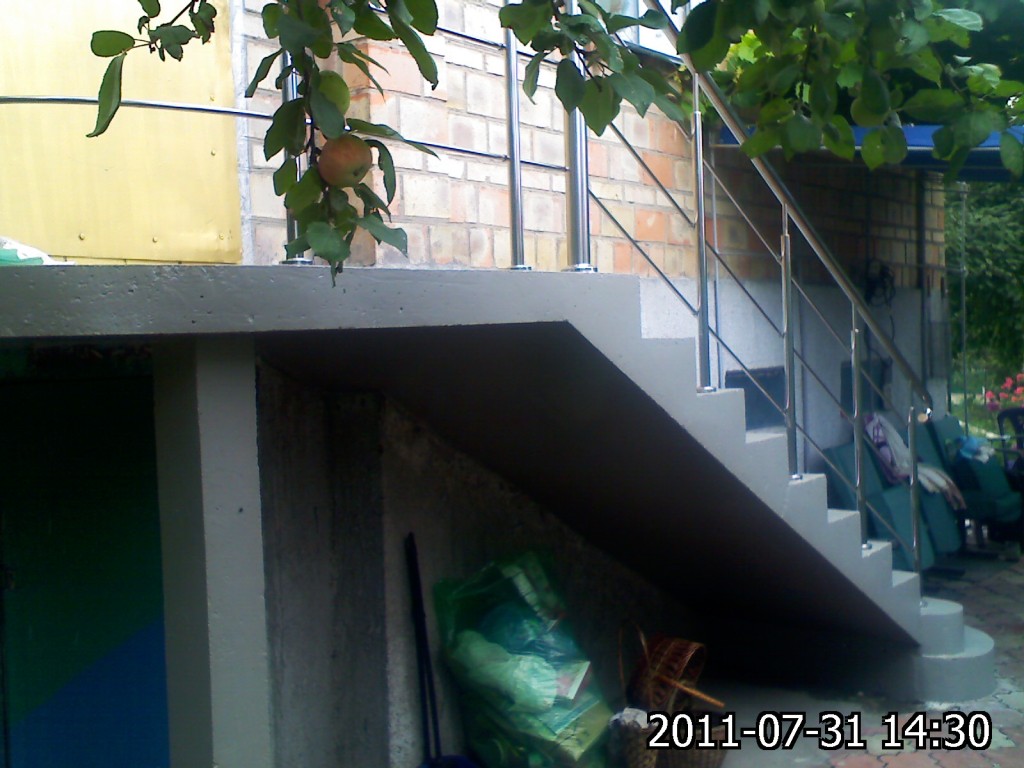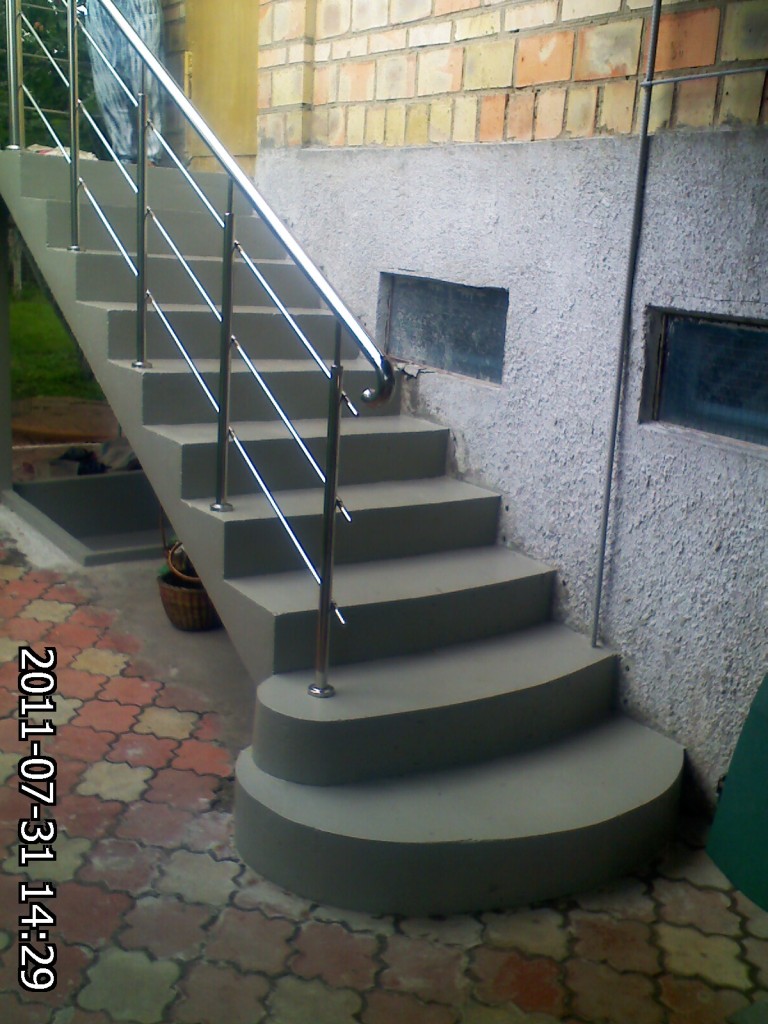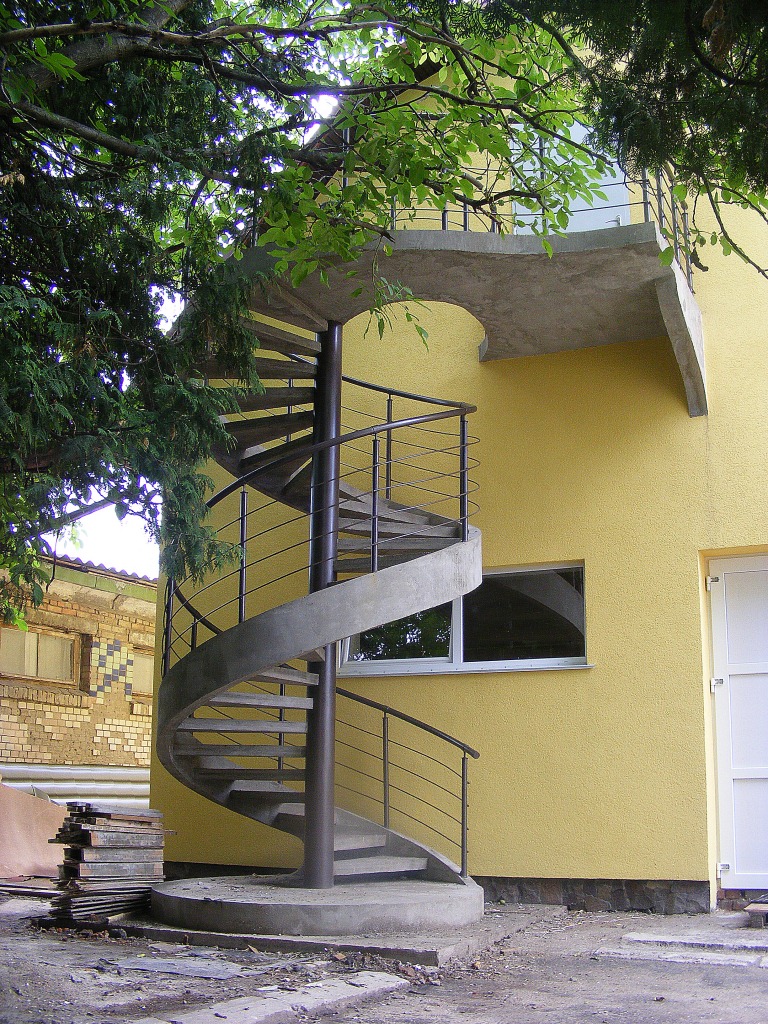Concrete stairs leading to the house must first of all be comfortable and safe. How to make street concrete stairs that meet the above conditions and what materials to use for this purpose?
Outdoor
stairs are exposed to extreme temperatures, rain, snowfall and heavy loads, so they must be strong and durable. During their construction, you should take care of optimal dimensions, strong material and strong cladding. It is worth knowing that the stairs leading to the house must be separate from it by construction and built on a separate foundation.
Dimensions of
concrete stairs leading to the house.
The dimensions and angle of inclination of the external stairs to the house must comply with building regulations. Optimal dimensions of stairs also play a big role in their convenient and safe use. So if the stairs are higher than a meter, they will need a railing. Stairs below one meter in height do not need to be supplemented with handrails. The height of the steps is 15-18 cm and the depth of 29-35 cm will ensure comfortable use of the stairs.
The area is also important when planning the dimensions of
concrete stairs . Its minimum width should be 0.9 m when opening the door inward. However, it should be remembered that stairs with a wider span will be more convenient to use. If the door opens outwards, the length of the platform must be at least 0.9 m, and the width of the door must be added to this value. It is also important to build a platform and steps with a slope of about 2 percent so that rainwater can flow freely from it.
What materials can be used to make street concrete stairs?
A popular solution is the construction of stairs from concrete, which can later be treated with various types of cladding. Entrance stairs can also be metal or above-ground from smaller elements.
- Concrete stairs - with this type of construction of external stairs, care should be taken to separate them from the building structure, otherwise thermal effects may occur and the stairs may crack. Concrete stairs should also have a separate foundation of blocks or thin concrete laid below the level of freezing of the ground. External concrete stairs can be built using formwork filled with reinforced concrete. First, the slab of the stairs is concreted, and then its steps. Another solution for concrete stairs is to build them from foundation blocks. Thanks to the wide possibilities of arrangement and almost any choice of cladding, concrete stairs easily harmonize with the facade and roof of the building.
- Metal stairs - a big advantage of external metal stairs is their speed of execution. They consist of ready-made elements that require twisting and installation on the foundation at the construction site. Most often, acid-resistant or carbon steel is used, well protected from corrosion and adverse weather conditions by means of hot-dip galvanizing or powder coating. Due to the ease of construction, metal stairs can be built on a foundation of foundation blocks. Steel stairs usually do not have steps, and their steps are made of a checkerboard or podium. A spectacular solution is the combination of an openwork steel structure with stairs made of wood or natural stone.
- Above-ground stairs - the above-ground construction of stairs allows you to use many interesting materials for their construction. Above-ground stairs can be made of natural stone, brick or cobblestone. Those made of stone will add a strong and elegant finish to the building. In order for them to be safe and convenient to use, you should choose a material with a structured surface and anti-slip properties. Erection of stairs on an above-ground structure is not difficult - it resembles laying a sidewalk in front of a house, and individual elements are laid on a properly selected masonry solution.
What cladding is suitable for the entrance
stairs ?
Before us is the choice of finishing material for external stairs, especially when we decide to use concrete stairs. The cladding of the stairs leading to the house must be resistant to changes in weather conditions, heavy loads and abrasion. The aesthetic aspect of this material is also important - the entrance stairs should be the showcase of the house and match its facade and roof, as well as the home garden, driveway or fence. Most often, ceramic granite, terracotta, clinker brick, natural stone or wood are used for this.
- Ceramic granite or terracotta for external stairs - frost-resistant ceramic granite or terracotta are often used as materials for finishing concrete stairs . The tile is quite cheap, easy to install and use. In addition, manufacturers offer a wide range of colors and patterns of tiles for outdoor use. When choosing them, you should pay attention to the fact that they are non-slippery, i.e. naturally rough or specially embossed.
- Clinker for external stairs - clinker tiles are a good way of finishing street stairs due to the high strength of the material and resistance to external factors. Clinker is frost-resistant, and thanks to its rough structure, it also has anti-slip properties. Clinker tiles also have low abrasion and water absorption. Made from natural ingredients, they are an environmentally friendly product. Their great advantage is also the variety of colors and shapes.
- Natural stone for external stairs - facing the entrance stairs with natural stone is a luxurious and very expensive solution, at the same time strong and durable. It will definitely be an investment for many years. When choosing a stone for outdoor stairs, you should take into account the degree of water absorption, resistance to abrasion and dirt, as well as the non-slip properties of the material. Not every natural stone is suitable for finishing external stairs due to different hardness and porosity. It is best to choose from strong and wear-resistant granite, sandstone and basalt.
- Wood for external concrete stairs. Wood as a cladding for concrete stairs is chosen because of its natural and timeless appearance. However, wooden boards require proper protection and systematic care, which will increase their resistance to changing weather conditions, and also increase the probability of maintaining good condition for many years. It should also be remembered that not all types of wood are suitable for outdoor use. In the case of entrance stairs, you should choose hard species such as oak, larch or spruce, or exotic species of wood.





